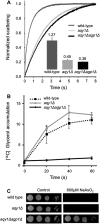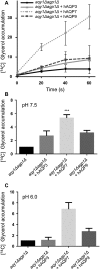Quantification of the Intracellular Life Time of Water Molecules to Measure Transport Rates of Human Aquaglyceroporins
- PMID: 28914342
- PMCID: PMC5696491
- DOI: 10.1007/s00232-017-9988-4
Quantification of the Intracellular Life Time of Water Molecules to Measure Transport Rates of Human Aquaglyceroporins
Abstract
Orthodox aquaporins are transmembrane channel proteins that facilitate rapid diffusion of water, while aquaglyceroporins facilitate the diffusion of small uncharged molecules such as glycerol and arsenic trioxide. Aquaglyceroporins play important roles in human physiology, in particular for glycerol metabolism and arsenic detoxification. We have developed a unique system applying the strain of the yeast Pichia pastoris, where the endogenous aquaporins/aquaglyceroporins have been removed and human aquaglyceroporins AQP3, AQP7, and AQP9 are recombinantly expressed enabling comparative permeability measurements between the expressed proteins. Using a newly established Nuclear Magnetic Resonance approach based on measurement of the intracellular life time of water, we propose that human aquaglyceroporins are poor facilitators of water and that the water transport efficiency is similar to that of passive diffusion across native cell membranes. This is distinctly different from glycerol and arsenic trioxide, where high glycerol transport efficiency was recorded.
Keywords: Aquaglyceroporin; Aquaporin; NMR; P. pastoris; Water transport.
Conflict of interest statement
Conflict of interest
The authors declare that they have no conflict of interest.
Ethical Statement
This article does not contain any studies with human participants or animals performed by any of the authors.
Figures






Similar articles
-
Aquaglyceroporins and orthodox aquaporins in human adipocytes.Biochim Biophys Acta Biomembr. 2022 Feb 1;1864(1):183795. doi: 10.1016/j.bbamem.2021.183795. Epub 2021 Oct 8. Biochim Biophys Acta Biomembr. 2022. PMID: 34627746
-
Aquaglyceroporins in Human Breast Cancer.Cells. 2023 Aug 31;12(17):2185. doi: 10.3390/cells12172185. Cells. 2023. PMID: 37681917 Free PMC article.
-
Arsenic transport by zebrafish aquaglyceroporins.BMC Mol Biol. 2009 Nov 25;10:104. doi: 10.1186/1471-2199-10-104. BMC Mol Biol. 2009. PMID: 19939263 Free PMC article.
-
On the definition, nomenclature and classification of water channel proteins (aquaporins and relatives).Mol Aspects Med. 2012 Oct-Dec;33(5-6):514-7. doi: 10.1016/j.mam.2012.04.003. Epub 2012 Apr 19. Mol Aspects Med. 2012. PMID: 22542572 Review.
-
Role of aquaporin-7 and aquaporin-9 in glycerol metabolism; involvement in obesity.Handb Exp Pharmacol. 2009;(190):233-49. doi: 10.1007/978-3-540-79885-9_12. Handb Exp Pharmacol. 2009. PMID: 19096781 Review.
Cited by
-
Cryo-EM structure supports a role of AQP7 as a junction protein.Nat Commun. 2023 Feb 3;14(1):600. doi: 10.1038/s41467-023-36272-y. Nat Commun. 2023. PMID: 36737436 Free PMC article.
-
In silico simulations of erythrocyte aquaporins with quantitative in vitro validation.RSC Adv. 2020;10(36):21283-21291. doi: 10.1039/d0ra03456h. Epub 2020 Jun 4. RSC Adv. 2020. PMID: 32612811 Free PMC article.
-
Quantitative study of unsaturated transport of glycerol through aquaglyceroporin that has high affinity for glycerol.RSC Adv. 2020;10(56):34203-34214. doi: 10.1039/d0ra05262k. Epub 2020 Sep 15. RSC Adv. 2020. PMID: 32944226 Free PMC article.
-
Crystallization of Human Aquaglyceroporins for Neutron Diffraction Studies.ACS Omega. 2025 Feb 20;10(8):7806-7812. doi: 10.1021/acsomega.4c08284. eCollection 2025 Mar 4. ACS Omega. 2025. PMID: 40060823 Free PMC article.
-
Single-channel permeability and glycerol affinity of human aquaglyceroporin AQP3.Biochim Biophys Acta Biomembr. 2019 Apr 1;1861(4):768-775. doi: 10.1016/j.bbamem.2019.01.008. Epub 2019 Jan 17. Biochim Biophys Acta Biomembr. 2019. PMID: 30659792 Free PMC article.
References
-
- Cregg JM. DNA-mediated transformation methods in molecular biology. 2007;389:27–42. - PubMed
MeSH terms
Substances
Grants and funding
LinkOut - more resources
Full Text Sources
Other Literature Sources

